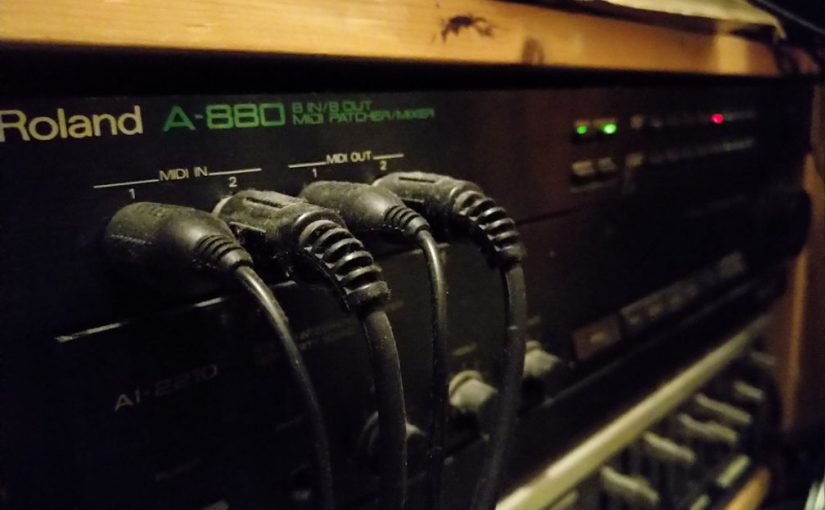Recently I had to revise some cabling and routing under the mixing desk, when I found a rack device. A MIDI patch bay, the A880. It was happily blinking and had silently done its useful job there for at least 10 years. After looking it up, it turned out to be an actually more than 30 years old product from Roland! You can also see the dust on the cables in my setup.
Then the question is: do you need a MIDI patch bay? The answer is twofold. MIDI itself is an ancient protocol. If you have MIDI devices and a computer hooked up via MIDI, I will say that you cannot do without a MIDI patch bay. However, MIDI is showing its age and probably some of you are using USB instead. Also, new MIDI standards are now seriously being discussed. Possibly resulting in something altogether new that may not be supported by the A-880.
The current standard MIDI protocol is ancient. And when you look at it technically it is also slow and limited. Of course it is fast enough to connect a keyboard to an instrument or a computer. Most devices allow daisy-chaining to connect any chain of computer and keyboard and MIDI instruments you have. However, that is when you will find that MIDI has its limitations. If you daisy-chain more than three devices you will likely hit one of its limitations: bandwidth. When too much information passes through a single chain, then you will get traffic jams and you might start hearing hick ups.
This is where a MIDI patch bay kicks in. Instead of daisy-chaining you can now connect devices in parallel. The A-880 connects 8 inputs to 8 outputs. Each of the individual connections to a midi device from the patch bay can now pass the maximum amount of data without traffic jams. Also with some simple button presses you can determine which input gets sent to which output. Allowing you to have more keyboards and route inputs from there to more devices. The forever friendly blinking lights show you which inputs go to which outputs.
Inputs 1 and 2 are special. They are positioned on the front panel and easily reachable when you assign those as merging inputs (<- edited because of Fred’s comment below). I use the patch bay in its most simple and useful form. The inputs from my main master keyboard are mixed with the input from the computer and then sent out through all remaining outputs at once. This is the blinking pattern that been the core of my setup for more than a decade. Only occasionally I push the Signal button. Then the blinking lights show which devices actually send data.
It may be that the future of MIDI does not include the A-880. This will be the moment when I will switch off this blinking, silently working work horse. And I will remove it from its hidden place under the mixing desk.

I have this unit! It’s the bomb! As I use almost entirely 80s/90s era gear, I can’t imagine ever getting rid of it.
You are so right!
Thanks for the article. I am having trouble getting it to work with sysex across my 1080, Korg 01R/W and JV-880. I use a USB keyboard to the PC so my main in and out is the PC Soundcard. How would you setup the in/outs on the synths so they work with sysex. Thanks
Wow. Maybe you need to draw this out. I hope you have a PC MIDI interface somewhere also?
I am fairly sure that you can merge any two inputs, but you can only have one merge (not necessarily 1 and 2 is what I mean)
You are so right! I read the manual again and I had been confused because of the indication of the 1st and 2nd inputs in the manual in the first explanation of the merge function. A little further on the same page it indeed explicitly states that any two inputs can be merged. Thanks for pointing that out!
I have a master midi controller on Channel 1 going into the A880 and then out to 7 synths and a drum machine.
They are all on different midi channels but sometime I want to play the exact same thing on 3 synths (stacking the sounds) and then other times I want to play them one at a time
Is there way to do this with the A880?
The A880 does not have any smart stuff built in that will make it do special pre-programmed tricks to my knowledge. In a live situation, the only way would be then if you could have your different presets listening to different channels. This is something that only the workstation type hardware synths can pull off I think. There are smarter midi mixers and mergers maybe?